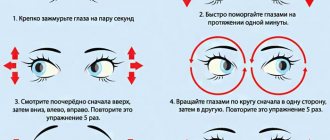In our lives, unfortunately, there are situations when removing an eye is the only right decision. A child's eye removed will not only cause huge complexes, but also deformation of the skull. An adult will also have many problems from an empty eyeball. For such cases, humanity has developed an eye prosthesis - it is intended for prevention and medical and sanitary measures.
An artificial eye protects a person from wind and dust, correctly shapes the position of the eyelids and skull bones, and prevents complications. The prosthesis will also relieve you of unnecessary embarrassment and complexes, and this is important when you are in society.
The indications for inserting such a device into the body are a complete examination, which results in the removal of the eyeball. Only a doctor can make such an important decision, therefore, you must first seek qualified help from an eye prosthetics center. Surgeons will perform a high-quality operation, select an individual prosthesis and monitor you throughout the postoperative period.
Types of prostheses
There are several types of eye prostheses:
- differ in purpose: postoperative, temporary and long-term wear;
- differ in materials: glass and plastic;
- individually ordered and mass produced;
- by characteristics: shape, size, side of wearing, color.
Each prosthesis has its own pros and cons, so it is necessary to select such a device individually. For example, glass dentures are very fragile, they need to be worn very carefully, and they only have a shelf life of a year. Such prostheses are made from various types of glass, are very light and well wetted. Therefore, if you are worried about the safety of your prosthesis, then it is better to choose plastic: it lasts about two years and is more durable.
When choosing a prosthesis, it is best to make it individual, since you will receive the same shape, color, and cavity features. The cost of such a device is much higher than the usual machine output, but in the end no one will see the difference between it and the seeing eye. First, the prosthetist will make an impression, after which you will select the required material, and he will begin designing.
Prosthetic eyeballs
Today, thousands of people in the world completely lose their vision every year due to degenerative retinal diseases. In this case, there is no way to correct it either with glasses or contact lenses. Over time, a person becomes blind. In order to help people with a similar illness, Stanford University specialists are working to create prosthetic eyeballs. Such devices must operate on the basis of current electronic technologies.
Scientists from Stanford University are trying to create prosthetic eyeballs that operate on the basis of modern electronic technologies. Currently, thousands of people around the world lose their vision every year due to degenerative retinal diseases. With them, there is a gradual loss of visual function, which cannot be corrected either with glasses or contact lenses. Over time, vision is completely lost and the person becomes blind.
Jim Ludin, the leader of the scientific team, managed to create a photovoltaic chip whose width is only a third of the thickness of a human hair. It is this, according to scientists, that should form the basis of a future electronic eye prosthesis.
Ludin writes: “The damaged retina cannot perceive light stimulation. The task of our chip is precisely to restore this ability to the retina.” An electronic eye prosthesis includes special glasses that can photograph surrounding objects, and then transform the resulting image into laser infrared radiation and transmit it to a chip implanted in the retina of the eye. The chip, in response to the received signal, begins to produce electrical impulses that stimulate the nerve cells of the retina, which makes it possible to construct certain visual perceptions.
Lundin explains the operation of the device this way: “Our device operates similarly to a remote control. You don’t see the signal when you start switching channels using it. But this signal is well received by a special unit on your TV. The same thing happens when using our invention. The eye is not able to see photons, but the electronic chip perceives them well and converts the signal into another form, which gives the retina the ability to perceive it.”
Studies conducted using rats as a laboratory model have shown that retinal neurons have the ability not only to pick up electrical impulses, but also to transmit them to the visual analyzer of the cerebral cortex. Scientists now face the problem of increasing the clarity and contrast of the resulting image. Before moving on to clinical trials of an electronic eye prosthesis, experts want to be sure that patients will be able to move independently in space, and it will be safe, first of all, for themselves.
Contraindications for prosthetics
Eye prosthetics cannot always be performed; there are a number of contraindications:
- in the presence of any serious inflammation of the iris, choroid, ciliary body, etc.;
- if there is high intraocular pressure;
- suspected ocular tumor;
- there is a foreign body in the eyeball.
If all these problems are present, no ophthalmologist will undertake prosthetics. Therefore, first you need to undergo a full examination, and after the doctor’s prescriptions, quality treatment. And in six months they will install such a device for you.
Specifics of image perception
Over the years of research, the bionic eye has undergone many changes and improvements. In early models, the image was transmitted from a video camera directly to the patient's eye. The signal was recorded on the photosensor matrix and passed through the nerve cells to the brain. But there was one drawback in this process - the difference in the perception of the image by the camera and the eyeball. That is, they did not work synchronously.
Another approach was to first send video information to a computer, which converted the visible image into infrared pulses. They were reflected from the lenses of the glasses and hit the photosensors through the lens into the retina. Naturally, the patient cannot see IR rays. But their effect is similar to the process of obtaining an image. In other words, a perceptible space is formed in front of a person with bionic eyes. And it happens like this: the image received from the active photoreceptors of the eye is superimposed on the image from the camera and projected onto the retina.
Types of eye prostheses
Fake eyes can look different. It depends on their type: an artificial eye will completely replace your eyeball when you lose your eyes; a prosthesis on an implant (endoprosthesis) is used after removal of the eyeball; biological and synthetic materials are used in the work; A scleral lens is needed to close an injured eye that can no longer see.
Only a doctor can advise which prosthesis is best to choose; no one else can choose the right device efficiently and professionally. Never self-medicate - this will definitely lead you to failure!
Argus II
The bionic eye is made in the United States. More than 130 patients are using this device today. The model is made of 2 elements: an implant and a miniature video camera implanted into glasses. All details of the surrounding world are captured by sensors and transmitted to the processor. The glasses are equipped with a wireless communication device. The implant activates the retina using implanted electrodes. Information through them is transmitted directly to the nerve fibers.
Patients learn to distinguish between horizontal and vertical lines a week after starting use. Gradually the quality of vision improves. The cost of the product is 150,000 pounds. Scientists continue to conduct research and improve the mechanisms of visual information reproduction.
The previous development was called Argus 1. The modern device differs from it in the large number of cells in the chip. The new system is more sensitive and allows 2 times more data to be transmitted to nerve fibers.
The implant uses 60 electrodes to stimulate the patient's remaining healthy retinal cells. Information is sent to the optic nerve, and the ability to distinguish colors, shapes and movement is restored.
Reasons for timely replacement of eye prosthesis
The prosthesis, of course, is a salvation for many, but, like all devices, it needs to be changed at some time. Remember that the eye device is a completely foreign body to your body; therefore, doctors and manufacturers advise changing such a device every two years.
Otherwise, the cavity narrows (the next time the device is changed, it simply won’t fit), the prosthesis itself becomes covered with microcracks (as a result of which serious inflammation can develop), mucus and cysts appear in the cavity, which will bring you discomfort (chronic conjunctivitis, entropion). Surgeons advise performing restoration of the device once a year.
Caring for your prosthesis
Before performing operations to insert and remove an eye prosthesis, wash your hands thoroughly and prepare eye drops, wipes, and a suction cup. Be sure to sit at a table covered with a soft cloth and place a mirror in front of you.
Removing the prosthesis
The procedure for removing the prosthesis is as follows:
- lift the upper eyelid;
- moisten the suction cup;
- Apply the compressed suction cup and press it to the simulated pupil;
- release the suction cup;
- run a little air under the prosthesis along the upper edge;
- slowly pull the suction cup forward;
- remove the prosthesis downwards.
Removing the eye prosthesis
How to install
How to insert a prosthesis yourself? Proceed as follows:
- Wash the product and carefully insert it under the upper eyelid (it is best to do this while the prosthesis is still wet).
- Look up and gently pull down your lower eyelid.
- Finish inserting the product by slightly turning it to the temporal side.
- Press down on the prosthesis and move it a little - this is necessary to release the air.
Installation of an eye prosthesis
How to clean
The prosthetic eye is washed in warm water and soap - alcohol should not be used. The postoperative product may not be removed. Be sure to strictly observe the rules of personal hygiene, keep your eyes closed while washing.
If the prosthesis remains in the eye cavity for a long time, it begins to irritate the conjunctiva.
How often is cleaning required?
Standard cleaning is done once every two weeks. Check with your doctor for details.
Cleaning the prosthetic eye
Psychological assistance after prosthetics
Loss of the organ of vision is a huge problem for humans! Naturally, problems arise: loss of self-confidence, acquisition of a large number of complexes, and much more. During the rehabilitation period, doctors advise people who have had such an operation not to tell anyone that the eye is not real. If possible, even to your family and friends. Then, according to psychologists, you will feel much more confident, and the people around you will not even notice the difference. Doctors also recommend taking a course of psychological assistance - a qualified specialist will help you understand the problems that are troubling you, and will leave everything a secret.
You don’t have to give up your usual activities: when playing sports, minimal restrictions are simply introduced, driving is allowed if the other eye has excellent vision, sewing and knitting, swimming - all this will remain accessible. The most important thing is that people will not suspect that you have such a secret.
Remember, if you have lost an eye, this does not mean that you need to become depressed and lose hope for a normal life. This is why eye prosthetics were invented - so that a person feels like a full-fledged member of society. Therefore, do not be upset, pull yourself together and continue to live happily!
Bionic eye in Russia
The first patient to have the device implanted in our country was 59-year-old Chelyabinsk resident Alexander Ulyanov. The operation lasted for 6 hours at the Scientific and Clinical Center of Otorhinolaryngology of the FMBA. The best ophthalmologists in the country monitored the patient’s rehabilitation period. During this time, electrical impulses were regularly sent to the chip installed by Ulyanov and the reaction was monitored. Alexander showed excellent results.
Of course, it does not distinguish colors and does not perceive numerous objects accessible to a healthy eye. Ulyanov sees the world around him blurry and in black and white. But this is enough for him to be absolutely happy. After all, for the last 20 years the man was generally blind. And now his life has been completely changed by the installed bionic eye. The cost of the operation in Russia is 150 thousand rubles. Well, plus the price of the eye itself, which was indicated above. For now, the device is being produced only in America, but over time, analogues should appear in Russia.








